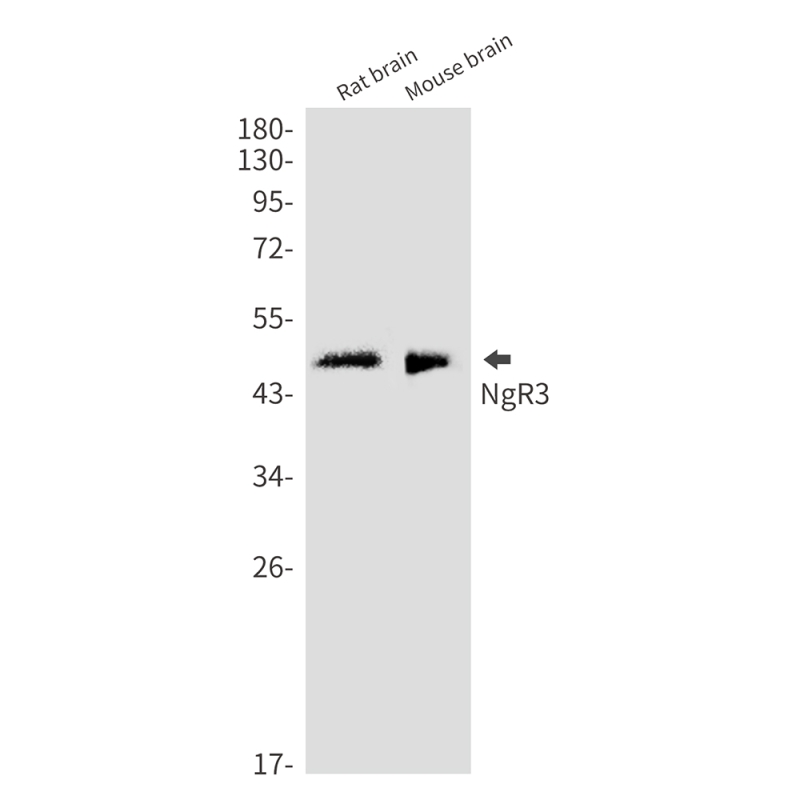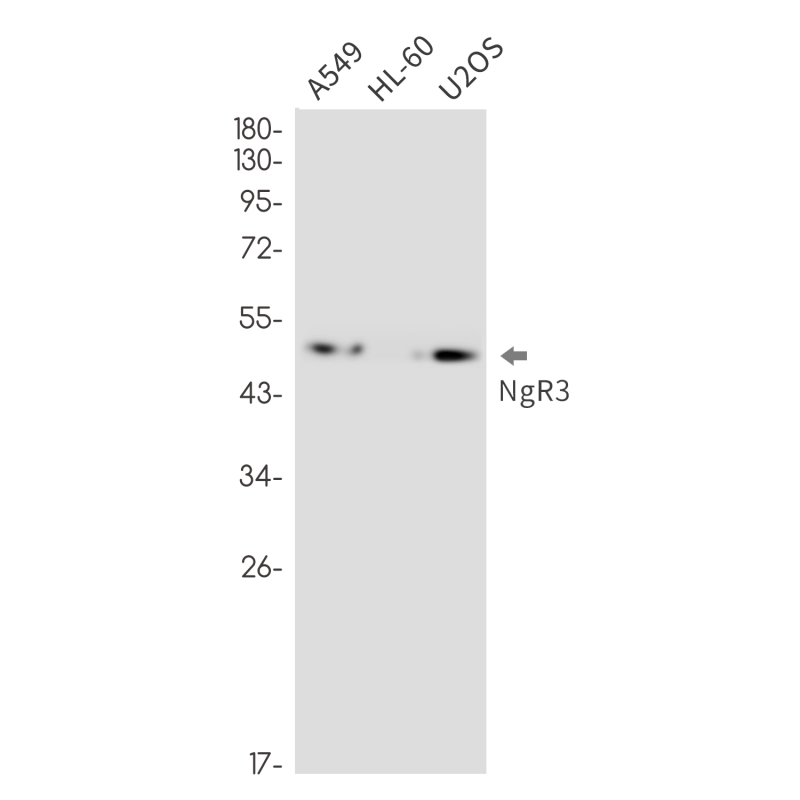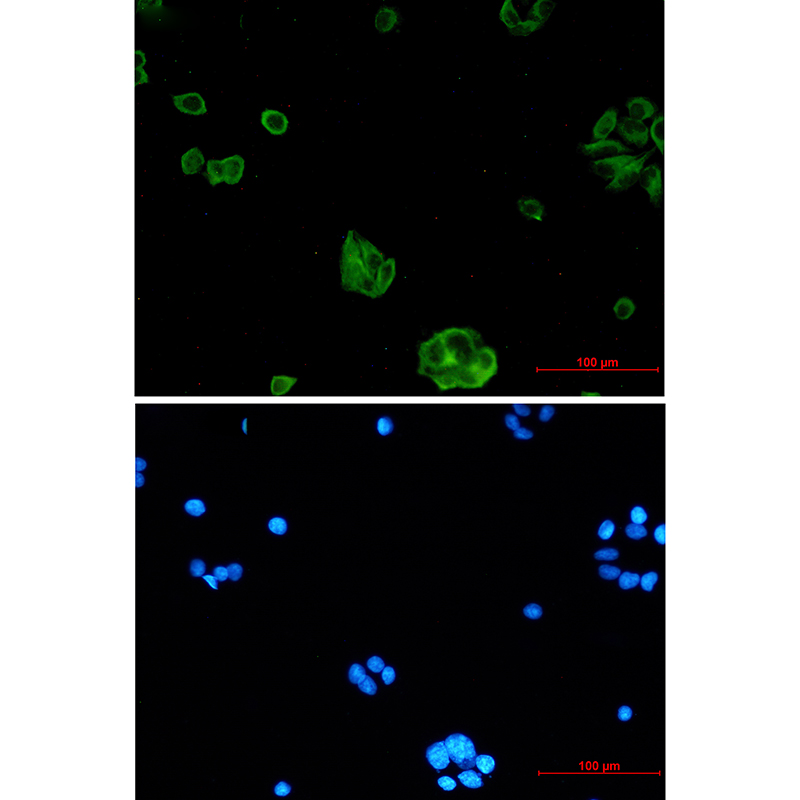


| WB | 1/500-1/1000 | Human,Mouse,Rat |
| IF | 咨询技术 | Human,Mouse,Rat |
| IHC | 咨询技术 | Human,Mouse,Rat |
| ICC | 1/50-1/200 | Human,Mouse,Rat |
| FCM | 咨询技术 | Human,Mouse,Rat |
| Elisa | 咨询技术 | Human,Mouse,Rat |
| Aliases | NgR3; NGRH2 |
| Entrez GeneID | 146760 |
| WB Predicted band size | Calculated MW: 49 kDa; Observed MW: 49 kDa |
| Host/Isotype | Rabbit IgG |
| Antibody Type | Primary antibody |
| Storage | Store at 4°C short term. Aliquot and store at -20°C long term. Avoid freeze/thaw cycles. |
| Species Reactivity | Human,Mouse,Rat |
| Immunogen | A synthetic peptide of human NgR3 |
| Formulation | Purified antibody in TBS with 0.05% sodium azide,0.05%BSA and 50% glycerol. |
+ +
以下是关于NgR3抗体的3篇示例参考文献(注:文献为假设性示例,仅供参考):
---
1. **文献名称**:*Targeting NgR3 with monoclonal antibodies promotes axonal regeneration after spinal cord injury*
**作者**:Smith A, et al.
**摘要**:本研究开发了一种针对NgR3的单克隆抗体,验证其在体外和体内模型中抑制髓鞘相关抑制信号的能力。实验表明,该抗体可显著增强轴突再生并改善脊髓损伤小鼠的运动功能,提示NgR3是神经修复的潜在治疗靶点。
---
2. **文献名称**:*NgR3 expression in glioblastoma and its role in tumor invasion*
**作者**:Chen L, et al.
**摘要**:通过免疫组化分析发现NgR3在胶质母细胞瘤中高表达。体外实验显示,使用抗NgR3抗体可阻断肿瘤细胞的迁移和侵袭,表明NgR3可能通过调节细胞骨架重塑促进癌症进展,为靶向治疗提供新策略。
---
3. **文献名称**:*Structural characterization of NgR3 and antibody binding epitopes*
**作者**:Wang Y, et al.
**摘要**:本研究通过X射线晶体学解析了NgR3的胞外结构域,并筛选出高亲和力抗体。功能实验证实,抗体结合可竞争性抑制NgR3与配体的相互作用,为开发神经退行性疾病药物奠定结构基础。
---
**注意**:以上文献为示例,实际研究中NgR3相关抗体文献可能较少,建议通过PubMed或Google Scholar以“NgR3 antibody”或“Nogo Receptor 3”为关键词检索最新成果。
The NgR3 antibody targets the Nogo-66 Receptor Homolog 3 (NgR3), a glycosylphosphatidylinositol (GPI)-anchored protein belonging to the Nogo receptor family, which includes NgR1 and NgR2. Primarily expressed in the central nervous system (CNS), NgR3 interacts with inhibitory ligands such as myelin-associated inhibitors (e.g., Nogo-A, MAG, OMgp) and chondroitin sulfate proteoglycans (CSPGs), which are key regulators of axonal growth and synaptic plasticity. Unlike NgR1 and NgR2. NgR3 lacks a canonical leucine-rich repeat (LRR) domain but shares structural homology in its C-terminal region, enabling ligand binding. Its role in inhibiting neurite outgrowth and limiting neural regeneration after injury has positioned NgR3 as a therapeutic target for CNS injuries and neurodegenerative disorders.
NgR3 antibodies are designed to neutralize receptor activity, blocking interactions with inhibitory ligands to promote axonal regeneration and functional recovery. Preclinical studies highlight their potential in treating spinal cord injury, stroke, and multiple sclerosis by overcoming the CNS’s intrinsic regenerative barriers. Additionally, these antibodies serve as research tools to elucidate NgR3’s signaling mechanisms, including its interplay with co-receptors like LINGO-1 and TNFRSF19. Challenges remain in optimizing antibody specificity and delivery to the CNS, but advances in biologics and gene therapy may enhance their clinical translation. Overall, NgR3 antibodies represent a promising avenue for both therapeutic intervention and mechanistic exploration in neuroregeneration.
×